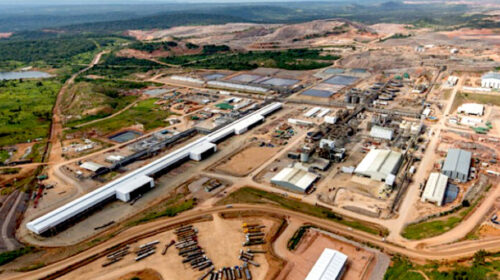Global copper market to see another year of volatile prices
As we look to 2020, copper is faced with a finely balanced market. For now, positive investor sentiment around copper’s fundamentals is supporting higher prices.
Stronger demand growth is underpinned by new semis capacity, while mine supply growth will be reliant on additions from both projects and existing mines.

Wood Mackenzie highlights 5 key trends to watch in 2020
Meanwhile, the recent approval of new copper scrap re-categorisation standards in China could yet determine the mix of copper raw material imports into the country and influence global scrap dynamics.
Red more about base metals
These fundamental factors, in addition to the strong geopolitical headwinds across the global landscape, will no doubt lead to another year of volatile prices. In the absence of a major economic downturn, copper’s supportive fundamentals should keep price risk skewed to the upside.
What are the biggest trends to watch in the global copper market in 2020?
Eleni Joannides, Wood Mackenzie Principal Analyst, sees five key themes:
- Copper prices – fundamentals vs sentiment
- Policies and politics that will drive copper demand
- The global scrap dynamics will shift – response to changes in Chinese scrap policies on imports
- Lower TC/RCs could push some smelters below break-even
- Mine supply looks set to return to growth
Joannides says:
“During 2019, copper prices were largely determined by US-China trade-related news rather than copper’s own fundamentals. It was not until the US-China Phase 1 trade deal was agreed in December that there was a shift in sentiment.
“As we look to 2020, the risk is that wider factors will once again influence price. The geopolitical issues that have surfaced since the start of the year could derail the rally that emerged in December 2019. On the other hand, further progress in resolving trade disputes will likely encourage a faster than anticipated recovery in demand and underpin prices.
“This year, we are forecasting that positive mine supply growth of 1.3% – after disruptions – will be offset by a recovery in demand. The resulting draw down in total cathode stocks by year-end should be positive for prices.”
According to Wood Mackenzie, differing incentive approaches to renewable technologies will lead to varied impacts on copper demand in 2020.
“Contributions to copper demand from electromobility and renewable energy will be a long-term story. However, in 2020, electric vehicles (EVs), wind and solar projects will see a range of incentives accelerate, stop and reverse. In some cases, this will be a drag on the development of projects. In other cases, however, a possible front-loading of projects ahead of further subsidy removal could emerge.
“The Chinese government recently announced that it has no plans to further reduce the subsidy on EVs in 2020. We believe the decision to keep the subsidy will help to support EV sales, production and related copper demand in 2020.
“This change in approach to EVs in China is in line with developments in other regions. In Europe, the likes of Germany and Norway continue to ramp up EV-related incentives, supporting copper consumption in the region. In consultation with German automakers, the so-called “Environmental Bonus” incentive has been raised to a maximum of €6,000 for battery EVs priced up to €40,000. In the US, some States have extended subsidy offerings, while others are introducing similar incentive programmes.
“In the renewable markets, the Chinese government plans to end the subsidy on newly approved onshore and offshore wind projects in 2021 and 2022, respectively. In the US, tax incentives for new solar power installations have started to wind down this year and the subsidy on wind power generation will also begin to decrease next year. As a result, we believe that demand for copper will be brought forward in both China and the US in 2020, as developers rush to install new capacity ahead of these changes,” said Joannides.
A shift in global scrap dynamics could occur in response to changes in Chinese scrap policies, Wood Mackenzie warns.
“The Chinese government recently approved new standards, beginning in July 2020, that will re-categorise some copper scrap as “renewable copper material”.
“The new threshold for copper content of imported copper scrap has been set at 97% and 56% for brass scrap. This threshold is noticeably above the average copper content for copper and brass scrap imported in 2019. Nevertheless, the copper industry in China has shown optimism towards scrap imports this year.
“Given that most of the examination will be done by visual inspection at ports, it is widely believed that implementation of the new standards will leave some room for scrap slightly below the threshold to be imported. However, the risk is that if Chinese Customs implement the new standards strictly, according to the guidelines, scrap processors will need to make additional efforts to meet the requirements. This means that China will be not be able to source as much scrap from the external market this year.
“In addition to the changes in scrap-related policies in China, rising costs to upgrade scrap ahead of export to China will likely incentivise more secondary consumption capability to be built in scrap generating and/or processing countries. We have already seen early examples of this around the world. It remains to be seen if this will be the start of a trend, which would not only have implications for scrap volumes available for China but also the requirement for concentrate, blister/anode and copper cathode,” said Joannides.
Partly driven by new project delivery, mine supply is expected to return to growth. Wood Mackenzie’s base case is for mine supply to reach 21Mt in 2020 – after applying a 5% disruption allowance. Notably, approximately 40% of the additional production capability will be a result of a net increase in output at operating mines.
“Projects that started in 2019 will support higher production as they ramp-up to full capability in the year ahead. Similarly, the increase of brownfield expansions and extensions will contribute a significant amount of supply growth. New projects that are scheduled to start during 2020 will also play their part.
“Glencore’s Mutanda mine in the DR Congo will be the largest planned decline in production in 2020. This accounts for 100 kt less mined copper supply year-on year,” added Joannides.
As with previous years, Wood Mackenzie expects a considerable amount of copper supply to be lost from unexpected disruptions. In addition to unforeseen operational and weather-related issues, social and political factors are central to supply risk.
“Approximately 40% of total disruptions recorded for 2019 were located at mines in the African Copperbelt. The environment in both cases appears more stable now, however. The initial upheaval brought about by tax and mining code changes in Zambia and DR Congo, respectively, has subsided as the mining industry comes to terms with changes to the operating environment.
“The more immediate issue facing Zambia now is power supply, with water levels in the country’s hydro-electric dams critically low,” said Joannides.
Lower treatment charges (TC) and refining charges (RC) could push some copper smelters below breakeven, according to Wood Mackenzie.
“A tight concentrate market in 2019 forced TC/RCs to their lowest level in six years. The 2020 benchmark was set at $62/t & 6.2c/lb – a 23% decrease on the 2019 benchmark and the fifth year of falling treatment charges.
“Our latest concentrate balance implies a deficit for 2020, with the addition of primary smelter capability outpacing growth in mine supply.
“However, with a lower annual TC/RC benchmark and very weak acid prices, some smelters in China are precariously close to breakeven. Therefore, smelter economics will have a bearing on the amount of available capacity in 2020.
“Outside China, aside from a continuing strike at Asarco’s Hayden smelter in the US, smelter stoppages are limited to planned maintenance so far. Smelting capacity in Chile is reaching full capability following the environmental refurbishments in 2019,” says Joannides.
Source: Mining Review





